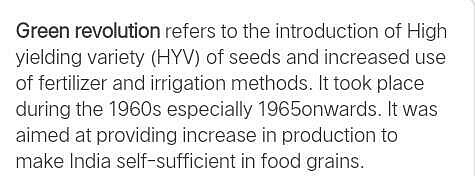Class 12 Exam > Class 12 Questions > Write a short note on Green Revolution?
Start Learning for Free
Write a short note on Green Revolution?
Most Upvoted Answer
Write a short note on Green Revolution?
Green Revolution
The Green Revolution refers to the introduction of high-yielding varieties of seeds, fertilizers, and pesticides in the agriculture sector. It is a term used to describe the transformation of agricultural practices that took place in the 20th century, particularly during the 1960s and 1970s.
Causes of Green Revolution
The Green Revolution was a response to the growing concerns about food security and the need to increase agricultural productivity. Some of the key factors that led to the Green Revolution include:
- Population growth: The world's population was rapidly increasing, and there were concerns about how to feed the growing population.
- Low agricultural productivity: Traditional farming practices were not producing enough food to meet the demand.
- Technological advancements: Advances in science and technology, particularly in the areas of genetics and plant breeding, made it possible to develop high-yielding varieties of crops.
Advantages of Green Revolution
The Green Revolution has had several advantages, including:
- Increased food production: The introduction of high-yielding varieties of seeds, fertilizers, and pesticides led to a significant increase in food production.
- Improved food security: The Green Revolution helped to improve food security in many parts of the world, particularly in developing countries.
- Increased income: The increased productivity of agriculture led to increased income for farmers.
- Reduced poverty: The Green Revolution helped to reduce poverty in many parts of the world by increasing agricultural productivity and creating new job opportunities.
Disadvantages of Green Revolution
Despite its many advantages, the Green Revolution has also had some disadvantages, including:
- Environmental problems: The use of fertilizers and pesticides has led to environmental problems such as soil erosion, water pollution, and loss of biodiversity.
- Dependence on technology: The Green Revolution has led to a dependence on technology, and many farmers are unable to afford the high costs of fertilizers and pesticides.
- Social problems: The Green Revolution has led to social problems such as the displacement of small farmers and the concentration of land ownership in the hands of a few large landowners.
Conclusion
In conclusion, the Green Revolution has had both positive and negative impacts on agriculture and society as a whole. While it has helped to increase food production and improve food security, it has also led to environmental problems and social inequalities. It is important to continue to improve agricultural practices and address the challenges posed by the Green Revolution to ensure a sustainable future.

|
Explore Courses for Class 12 exam
|

|
Write a short note on Green Revolution?
Question Description
Write a short note on Green Revolution? for Class 12 2024 is part of Class 12 preparation. The Question and answers have been prepared according to the Class 12 exam syllabus. Information about Write a short note on Green Revolution? covers all topics & solutions for Class 12 2024 Exam. Find important definitions, questions, meanings, examples, exercises and tests below for Write a short note on Green Revolution?.
Write a short note on Green Revolution? for Class 12 2024 is part of Class 12 preparation. The Question and answers have been prepared according to the Class 12 exam syllabus. Information about Write a short note on Green Revolution? covers all topics & solutions for Class 12 2024 Exam. Find important definitions, questions, meanings, examples, exercises and tests below for Write a short note on Green Revolution?.
Solutions for Write a short note on Green Revolution? in English & in Hindi are available as part of our courses for Class 12.
Download more important topics, notes, lectures and mock test series for Class 12 Exam by signing up for free.
Here you can find the meaning of Write a short note on Green Revolution? defined & explained in the simplest way possible. Besides giving the explanation of
Write a short note on Green Revolution?, a detailed solution for Write a short note on Green Revolution? has been provided alongside types of Write a short note on Green Revolution? theory, EduRev gives you an
ample number of questions to practice Write a short note on Green Revolution? tests, examples and also practice Class 12 tests.

|
Explore Courses for Class 12 exam
|

|
Signup for Free!
Signup to see your scores go up within 7 days! Learn & Practice with 1000+ FREE Notes, Videos & Tests.




















